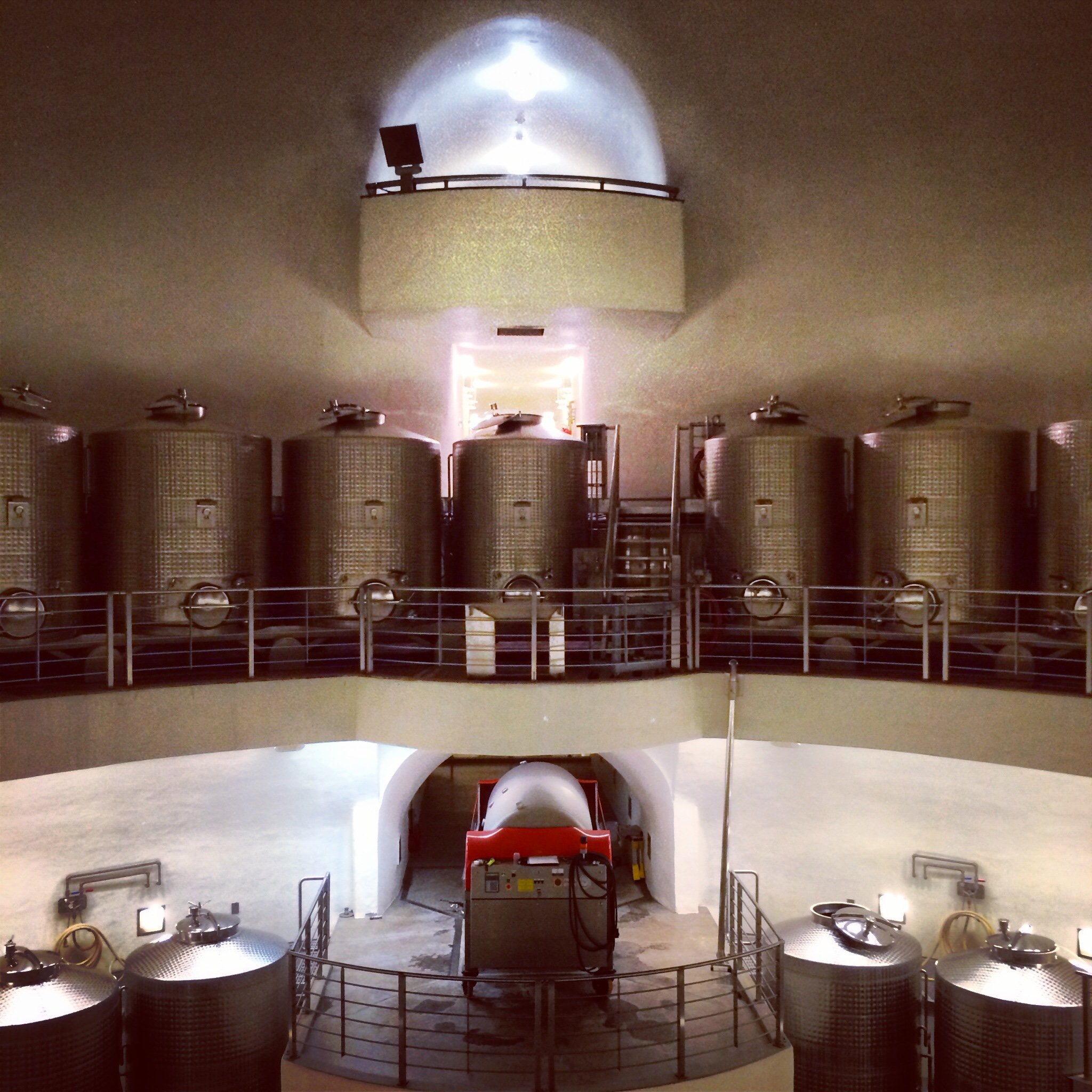The Best Cave Tours in Napa Valley
Wine caves are a feature of Napa Valley that gives wine tours a glimpse of the Old World, where wine caves have been utilized for centuries. Not only are caves instrumental to the wine aging process, providing a consistent temperature year-round and a high level of humidity that slows evaporation, they also feature a mystique that can take you away from the minutiae of daily life and transport you to a world of silky wines, engaging hosts and the beauty that Napa can offer. Not every winery in Napa has a cave and some are better than others so check out a list of our favorites cave tours to see which ones you should put on your bucket list.
The caves at Palmaz Winery
Fantesca
Duane and Susan Hoff wanted to make Fantesca the best winery on Spring Mountain and they have definitely achieved that goal in part by having not one, but two of the best winemakers in Napa Valley working to make these incredible wines. Both Heidi Barrett and Tony Arcudi work tirelessly to make Fantesca and they get to use one of the more interesting wine caves in Napa to age them.
This cave is unique for a couple of reasons. Firstly, it has two entrances, which is something not many Napa wineries can claim. The first entrance originates at the winery where you start your tour, and as you walk deep into the cave you start to notice at the other end of the long hall, another set of doors that open to the palatial estate on which Duane and Susan (the owners of Fantesca) currently reside, making this one of the shortest commutes to work on the planet.
Secondly, the cave was built in the 90s with the mission of searching for deposits of silver and gold, however, some say this may have been a clever ruse to bypass the radical building restrictions of Napa County. Either way, once the cave was dug, there was, unfortunately, no gold to be found so they settled on fortifying the walls and using it to age their barrels. Now you can find all kinds of wine being aged in this underground lair, including all of the Fantesca wines, Fearless (The project of Chelsea Hoff), Arcudi, and some of Heidi’s wines as well. It’s a wonderful place to see and it’s open to wine lovers by appointment only.
Vineyard 29
Chuck & Anne McMinn at Vineyard 29 spare no expense when it comes to making their wine, from replacing their large oak fermentation tanks every 5 years to the highly intensive sorting process, you can taste that this wine was made with excellence in mind, and their wine cave experience is just the same.
Tours may start in a beautiful room with floor to ceiling windows looking over the vineyards below, but they culminate in a full tasting deep into their wine cave where they house their Library Tasting room. This room is stocked full of large format and older vintage bottles of Vineyard 29 as well as some select wines the owners have collected over the years. As you take the tour through the winery you enter this cave and see barrels neatly lined on both sides of the wall. Most of these barrels are filled with their red wine, but you may also notice a small arm of the cave that houses their steamed barrels filled with Sauvignon Blanc. This oak aged Sauvignon Blanc is amazingly light due to the steam heated treatment rather than traditional fire used in the red wine barrels. Another thing to note is the gentle slope of the wine cave, something unique to Vineyard 29 which is used to move water out of the cave during the necessary cleaning that takes place. The cave at Vineyard 29 shows visitors that they spare no expense when making their wine, and it shows when it’s in the glass. Fortunately you can see both the cave and the wine if you book a tour, but only if you book the Private Estate Tasting.
Porter Family Vineyards
Tom and Beverly Porter built this winery almost completely underground in a wine cave they dug into the hillside where their winery is located in Coombsville. They have only been releasing wine since 2008, and with a mere 2000 cases in production, they have decided to focus on quality instead of quantity.
This is a beautiful and very interesting area of Napa. It is as close as you can get to San Pablo Bay and still make Cabernet driven reds because of the cool breeze and fog that the Bay pushes this way. During the tunneling of the caves they discovered a number of fossilized footprints of Sandpiper birds from over 5 million years ago meaning that at one point San Pablo Bay or even the Pacific ended where this property now sits. Because of this they decided to create the Sandpiper Red, a Bordeaux blend dedicated to the significance of their location.
When touring the property you first walk through the vineyard before arriving at a beautifully decorated tasting room deep in the WiFi-enabled wine cave, where you will taste a variety of wines paired with small bites including delicious chocolate from Napa’s own chocolatier, Annette’s Chocolates. This cave is replete with sophisticated climate-controlling technology that adjusts for a variety of factors including humidity, temperature, and external conditions such as cave doors being opened and closed making Porter Family Vineyards not only a leader in winery technology but also a producer of some of the best wines in Coombsville.
Jarvis Estate
William and Leticia Jarvis created an incredible estate in the Vaca Mountains entirely underground, which has left the property as beautiful as nature intended. With the help of Dimitri Tchelistcheff, son of famous winemaker Andre Tchelistcheff they have created a unique selection of beautiful wines from one of the most diverse vineyards in all of Napa Valley. Here you can find the expected Cabernet Sauvignon and Chardonnay, but you’ll also find more exotic varietals such as Tempranillo, Pedro Ximenez, and Muscat.
The wine cave at Jarvis Estate covers an impressive 45,000 square feet, making it one of the biggest in the Valley. It was built in the shape of a parabola, with the belief that parabolic structures are the most stable of all designs. The largest area of the cave, the one that houses the fermentation tanks, is actually large enough to fit two basketball courts. A natural spring within the cave system was discovered while drilling the cave and rather than plug it up and take the risk of it leaking out somewhere else in the cave they decided to incorporate the water as a feature of the cave. Now when you tour the caves you will find a beautiful waterfall flowing into a ‘river channel’ on the floor of one of the tunnels. Not only is it an impressive sight to behold, this extra water actually helps maintain a higher humidity content – and helps limit the evaporation of their wines in the barrels.
The entrance to the tasting grotto is a must-see in Napa Valley. To get to the tasting room you have to cross several large stones over the ‘river channel’ which leads to a beautiful tasting room in the cave where you and up to 9 other people get to sample six Jarvis Estate and Reserve Collection wines while seated at a large stone table. In addition to this main tasting room, there is the Crystal Room, which contains large geodes of amethyst and other crystals imported from Brazil. Another cavern comfortably fits up to 500 people and is the location of many of Napa’s best private events. Make sure you reserve your tasting ahead of time before someone else beats you to it.
Palmaz Vineyards
Julio Palmaz made history with the coronary stent he patented in 1985, but rather than rest after changing the lives of so many, he decided to create Palmaz Vineyards, a 600 acre estate located at the end of Hagen Road just northeast of the town of Napa. This is truly a family affair with Julio, Amalia, and their two children Florencia and Christian running day-to-day operations. They also feature the most impressive cave in all of Napa Valley. This is definitely the number one cave on our list.
This cave is nearly 110,000 square feet making it at least two times the size of the next largest winery cave in Napa Valley. The tour starts on the fourth floor and will walk you through several levels of the cave; everything during the wine-making process is conducted by gravity flow, where a winery will utilize the gentle force of gravity over the violent actions of machine pumps. The most impressive part of the cave system is the world’s largest underground reinforced structure, a fermentation dome that stands at 54 feet tall and houses the most advanced technology in Napa winemaking. The dome is often covered in the projection of data that is streaming in from each fermentation tank, and which can also be accessed and manipulated by iPad. Other cave features include a huge wine elevator for transporting the large tanks between cavern levels, as well as the winery’s own water treatment plant which can store up to 1.2 million gallons of water deep underground. This water is then reused to water the plants and vines on the property.
Tastings are held at a long table surrounded by stone arches in one of several elegantly decorated small rooms on the fourth floor of the caves. All wines are paired with cheese and other specially prepared hor d’oeuvres such as truffles or smoked salmon with wasabi-infused caviar. The menu changes regularly so you never know what you are going to get. As can be expected, it can be very difficult to get an appointment at Palmaz Vineyards so book your trip early and put this on the list.
That covers some of the most interesting, unique, and beautiful caves in Napa Valley, but if you really want to know about them then you need to get out to Napa and see for yourself. Contact us at Bin 415 and we’ll be happy to get your tour booked right away!

